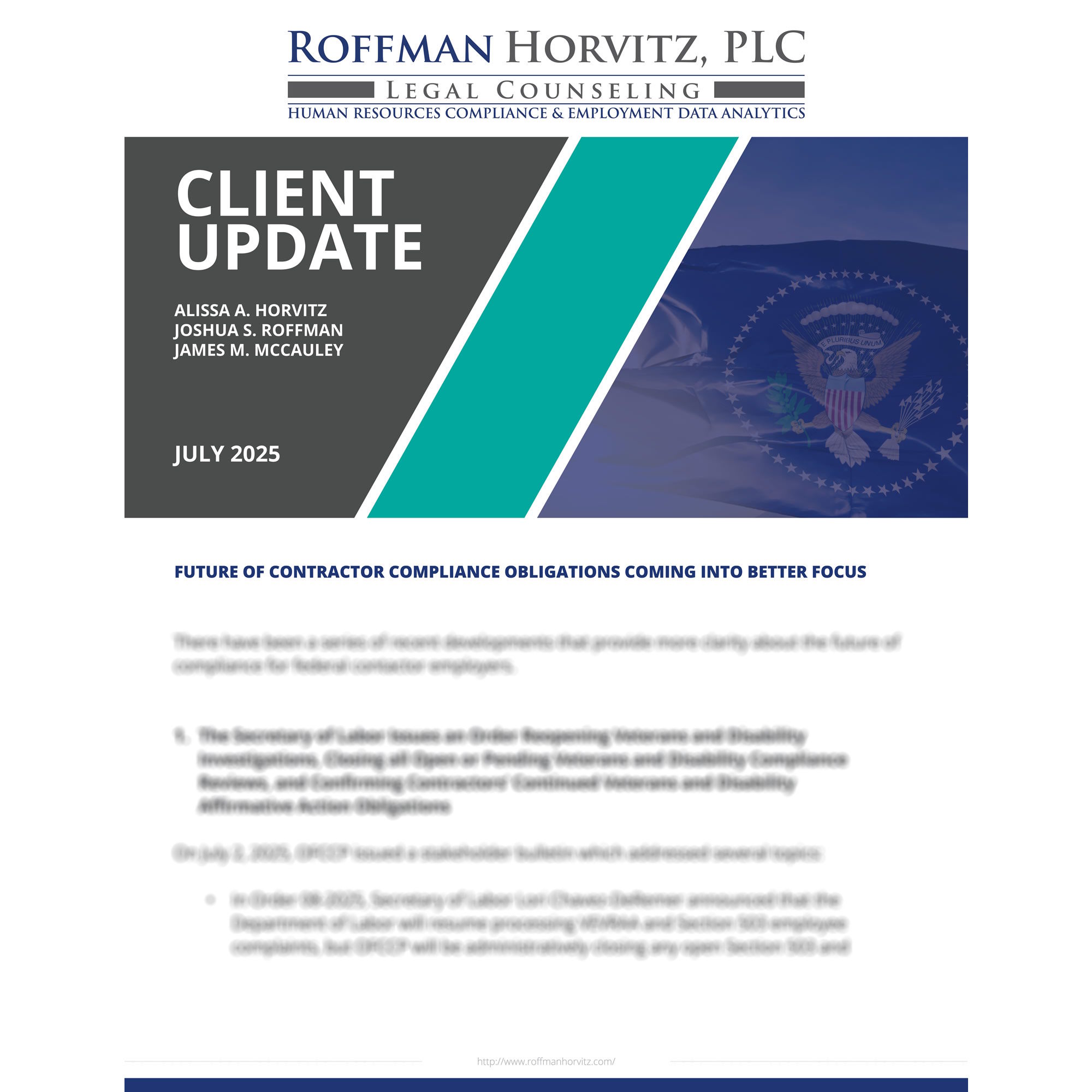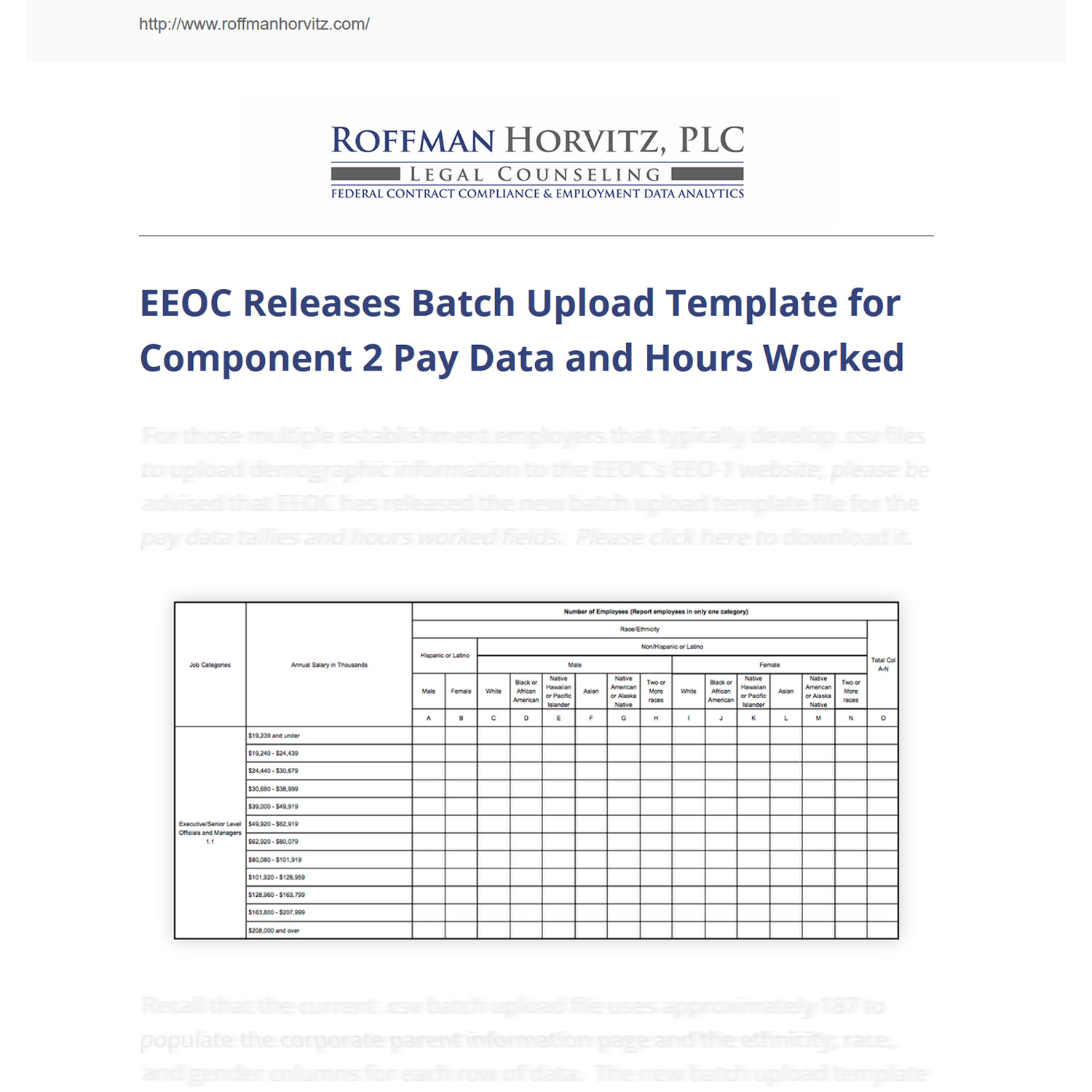Client Update: December 2022

This Client Update addresses five topics:
- OFCCP's decision to update the disability self-identification form;
- EEOC's release of a new EEO is the Law Poster;
- The status of the FOIA requests for employer EEO-1 data from 2016-2020 and employer objections;
- OFCCP's revised compensation analysis directive and the implications for a privileged pay analysis; and
- Preparing for the upcoming 2023 California Pay Data reporting cycle.
We provide additional context for the first two edits we mentioned above:
1. OFCCP Proposes to Modify Disability Self-identification Form
On November 16, OFCCP notified the government contractor community of its intent to update the disability self-identification form (again). OFCCP published a notice in The Federal Register, and it is accepting comments on its proposed new form until January 17, 2023. It hopes to have the new form ready to go when the current version expires on May 31, 2023. A copy of the proposed form may be found here:
https://www.regulations.gov/document/OFCCP-2022-0003-0003
What is the take-away: Contractors will have 90 days from when OFCCP publishes the final version of the form to integrate it into their application and hiring processes and to use this new form when they re-survey their entire employee population at the next 5-year interval.
What are the changes to the disability form?
There are three groups of edits to the form:
- tweaks in the description of current disabilities;
- addition of eight impairments; and
- formatting changes at the top of the form to explain in plain English the reasons why employers are asking for this information.
- Language tweaks:
Current Form Proposed Form Cancer Cancer (past or present) Epilepsy Epilepsy or other seizure disorder Intellectual Disability llectual or developmental disability Mental Health Condition Mental Health Condition
- Addition of Eight Impairments:
- Disfigurement, for example, disfigurement caused by burns, wounds, accidents, or congenital disorders
- Mobility impairment, benefiting from the use of a wheelchair, scooter, walker, leg brace(s) and/or other supports
- Neurodivergence, for example, attention-deficit/hyperactivity disorder (ADHD), autism spectrum disorder, dyslexia, dyspraxia, other learning disabilities
- Partial or complete paralysis (any cause)
- Pulmonary or respiratory condition, for example tuberculosis, asthma, emphysema
- Short stature (dwarfism)
- Substance use disorder (not currently using drugs illegally), and
- Traumatic brain injury
- Simplification of language at the top: OFCCP is proposing to begin the form with simplified language:
We are a federal contractor or subcontractor. The law requires us to provide equal employment opportunity to qualified people with disabilities. We have a goal of having at least 7% of our workers as people with disabilities. The law says we must measure our progress towards this goal. To do this, we must ask applicants and employees if they have a disability or have ever had one. People can become disabled, so we need to ask this question at least every five years.
Roffman Horvitz does not intend to object to these edits and is still determining whether to submit comments in support.
2. EEO is the Law Poster – Revised
In case you did not receive an email from the Equal Employment Opportunity Commission or the company that sells you the EEO is the Law Poster, EEOC has updated it. Here is a PDF version of the new poster, and government contractor employers must display both pages.
https://www.eeoc.gov/sites/default/files/2022-10/22-088_EEOC_KnowYourRights_10_20.pdf
Please keep in mind that OFCCP's disability and veteran regulations require you to make this notice available to applicants and employees, which means that many employers have a link to this document on their career website landing pages and/or applicant tracking system landing pages. If your systems link to older versions of this poster, please remember to update those links, too.
A question we get asked frequently is whether employers have to display a physical poster on a bulletin board, or is electronic posting on an intranet sufficient?
- An intranet doesn't make the poster accessible to applicants, so if the question is whether you can upload it to your intranet for employees and also put it on an applicant tracking system or career landing page for applicants – the answer is "possibly."
- OFCCP's regulations have more force of law than its frequently asked questions. The regulations still say "bulletin boards," but since the pandemic, its FAQs have allowed electronic posting.
- During the pandemic, when OFCCP was working from home and when it was conducting virtual onsites, we are not aware of any compliance officer that cited a client for providing a PDF version of how the notice appears on their websites (intranet version for employees and external version for applicants).
OFCCP is starting to resume doing onsites in person, and not just virtually. We'll see how vigorously OFCCP enforces the bulletin board regulation and will update clients if we see any trends.
3. Status of the FOIA Objections and OFCCP’s Release of EEO-1 Data
In response to the Center for Investigative Reporting's Freedom of Information Request to OFCCP, October 19, 2022 was the last date on which government contractor employers could file objections in OFCCP's FOIA Portal, seeking to prevent the disclosure of their 2016-2020 EEO-1 Type 2 Consolidated forms.
- On November 1, 2022, OFCCP's FOIA officer emailed the reporter (Will Evans) and noted that "OFCCP intends to release to [CIR] the names of those federal contractors that objected under an applicable FOIA exemption and whose data was removed from public release."
- OFCCP was in the process of cataloguing the objections when CIR filed a lawsuit in federal court (in the Northern District of California) on November 15, 2022. Because CIR filed its lawsuit, our understanding is that OFCCP suspended processing the list of objectors until it received further directions from its attorneys.
- There is no confirmed timeline on when OFCCP will turn over to CIR (1) the EEO-1 data of employers that did not object and (2) the list of employers that objected.
- On November 22, OFCCP emailed employers from whom it had not received objections, using the email address from the EEO-1 submission, to notify them that their organization's data was going to be released. Its email stated: "Because we have received no objection, we are providing your organization with notice that its Type 2 EEO-1 data is subject to release under FOIA, and OFCCP intends to release this data after January 2, 2023." [But OFCCP's "intention" to release the data of non-objectors may get pushed back to a later date, as well]
As soon as we learn of any updates to the timeline, particularly insofar as providing CIR with the list of objecting oragnizations, we will email clients again.
4. OFCCP’s Revised Compensation Directive: What are the Implications for Privileged Pay Analyses
On August 18, 2022, OFCCP issued a revision to Directive 2022-01, "Pay Equity Audits," that clarified the agency's guidance on the confidentiality of compensation audits conducted by contractors pursuant to 41 CFR 60-2.17(b)(3). The gist of what you will read in more detail below is that employers certainly may continue to evaluate pay under the attorney client privilege, but if you want to claim privilege in an audit, there are a number of requirements that you will need to satisfy.
Since the year 2000 (the last time when OFCCP addressed section 2.17(b)(3)), OFCCP's regulations have required employers to conduct an annual analysis of compensation disparities. The latest controversy arose because OFCCP's March 15, 2022 directive (described below) seemed to imply that contractors no longer could claim attorney client privilege over those analyses during a compliance review or audit.
Under the original Directive issued on March 15, 2022, contractors were required to conduct a "pay equity audit" and then "provide a complete copy" of that audit to OFCCP during a compliance review to meet their regulatory obligation to analyze compensation. The Directive immediately was met with backlash because many contractors conduct pay equity audits under attorney client privilege to safeguard the sensitive nature of the compensation analyses, and they did not wish to provide documentation to OFCCP that they believed was covered by attorney-client privilege and/or the attorney work product doctrine. Additionally, the use of the phrase "pay equity audit" in the Directive made it unclear to contractors whether they had to provide all compensation reviews or audits they were undertaking, regardless of whether those audits were being done to comply with OFCCP regulations, or for other legal or non-legal reasons.
In response to that backlash, OFCCP revised and reissued Directive 2022-01 in August. OFCCP explicitly reaffirmed that contractors do not need to provide privileged communications or attorney work product to satisfy their compensation analysis requirements. Furthermore, the revised Directive no longer uses the phrase "Pay Equity Audits" and instead uses "compensation review" to avoid any confusion about the nature of the contractor's compensation analysis obligation. However, the revised Directive also maintains OFCCP's stance that "a contractor will not be found in compliance with their compensation analysis obligations if they simply invoke privilege and provide OFCCP with no or insufficient documentation of compliance." Rather, contractors must provide separate, nonprivileged documentation that demonstrates the contractor conducted a compensation review in accordance with OFCCP regulations. The revised Directive states that this documentation can be provided:
- as a redacted version of the contractor's compensation analysis,
- as a separate analysis performed during the relevant AAP period, or
- as a detailed affidavit.
Regardless of which option a contactor chooses, the documentation provided to OFCCP must demonstrate:
- when the compensation analysis was completed;
- the number of employees the compensation analysis included and the number and categories of employees the compensation analysis excluded;
- which forms of compensation were analyzed and, where applicable, how the different forms of compensation were separated or combined for analysis (e.g., base pay alone, base pay combined with bonuses, etc.);
- that compensation was analyzed by gender, race, and ethnicity; and
- the method of analysis employed by the contractor (e.g., multiple regression analysis, decomposition regression analysis, meta-analytic tests of z-scores, compa-ratio regression analysis, rank-sums tests, career-stall analysis, average pay ratio, cohort analysis, etc.).
The Directive also recommends providing OFCCP with the following information to help understand how contractors evaluate their compensation systems in practice:
- all employee pay groupings evaluated;
- an explanation of how and why employees were grouped for the analysis;
- which, if any, variables, factors, measures, or controls (e.g., tenure, education, structural groupings, performance ratings, prior experience) were considered and how they were incorporated in the analysis; and
- the model statistics for any regressions or global analyses conducted (e.g., b-coefficients, significance tests, F-tests, etc.) for race, ethnicity, and gender-based variables.
OFCCP recognized that these four categories of information are likely to be considered privileged by contractors and thus they should only be provided if they are maintained in nonprivileged form and only for the purpose of conducting an efficient compliance evaluation.
Finally, the Directive reiterates contractors' obligation under 41 CFR 60-2.17(b)(3) to develop and execute action-oriented programs to correct any problem areas found as a result of the compensation analysis. To ensure contractors are engaging in good faith efforts to comply with this follow-up obligation, OFCCP will request documentation that the contractor created action-oriented programs to address any problem areas and to "evaluate the contractor's good faith efforts to remove identified barriers, expand employment opportunities, and produce measurable results." At a minimum, this documentation must demonstrate:
- the nature and extent of any pay disparities found, including the categories of jobs for which disparities were found, the degree of the disparities, and the groups adversely affected;
- whether the contractor investigated the reasons for any pay disparities found;
- that the contractor has instituted action-oriented programs designed to correct any problem areas identified;
- the nature and scope of these programs, including the job(s) for which the programs apply and any changes (e.g., pay increases, amendments to compensation policies and procedures) the contractor made to the compensation system; and
- how the contractor intends to measure the impact of these programs on employment opportunities and identified barriers.
In light of this revision to Directive 2022-01, contractors (and especially contractors that are identified in any future heads-up audit list or CSAL list that OFCCP issues) should carefully evaluate how they plan to comply with 41 CFR 60-2.17(b)(3), the action-oriented section of their plans, and the internal audit section of their plans, to ensure they are not waiving attorney-client privilege on the compensation analyses they perform and that they remain in compliance with the other regulatory plan obligations. Contractors can reduce this risk by conducting a less detailed compensation analysis to satisfy the regulatory requirement that is separate from a more in-depth analysis performed by counsel.
5. California Pay Transparency and the 2023 California Pay Data Reporting Cycle
By way of reminder, private employers that have 100 or more employees, and who have employees that reside in or work in California, are required to file a pay data report with the California Civil Rights Department (CRD) each year. California recently amended its pay data law to require that this report be submitted on or before the second Wednesday in May each year. In 2023, the deadline is May 10, 2023. The amendments also require employers, which hired 100 or more employees from "labor contractors" within the prior calendar year, to include them in the data pull, and the amendments changed the reporting format for the next reporting cycle:
- No longer will employers be allowed to submit a consolidated report; in 2023, employers with multiple establishments will need to submit a report covering each establishment.
- For each establishment, employers will need the establishment ID, name, street address, city, state, zip, NAICS code, major activity, total number of employees at the establishment, and whether a CA pay data report was filed for the past year
- In addition, per the bullet point below, for employers that hired 100 or more employees from a labor contractor in 2022, it will be important to know which employees were hired through a labor contractor because those employees will be tallied and summarized in a separate report.
- Labor contractor is defined as "an individual or entity that supplies, either with or without a contract, a client employer with workers to perform labor within the client employer's usual course of business." Employers will be required to disclose the ownership names of all labor contractors used to supply employees. The labor contractor is required to supply all pay data to the private employer.
- Employers should NOT pull their data until California releases the data template for the 2022 data pull. Because California wants employers to place a count of employees by pay band for each gender, race, and ethnicity combination and wants employers to calculate the median and mean hourly rate for each gender, race, and ethnicity combination, it is not clear whether California is expecting employers to format one single worksheet or multiple worksheets, and how employers who hired more than 100 employees from a labor contractor will be reporting those individuals.
Once the CA template for the data pull has been released, we will supplement this client alert.
Although it is not related to the evaluation of wage data through a race or gender lens, we also bring to your attention that this new California law requires employers to maintain job title and wage rate history for each employee for the duration of their employment plus for three years after the end of their employment. This record retention obligation is longer than the record retention obligation for similar records under OFCCP's record retention regulations and may prompt multi-state employers with operations in California to review their record retention and automatic document destruction practices.
Finally, employers with 15 or more employees must include pay scale data on all job postings effective January 1, 2023, including postings that are being made for you by diversity and outreach vendors. Please ensure that when these diversity job vendors come onto your career site and scrape the postings to disseminate them to veteran, disability, minority, and women outreach sources, they are grabbing information on pay scale now, too. California's new law does not expressly say whether the disclosure requirements apply to job postings for positions outside of California if posted by a California employer with more than 15 employees; the law also does not expressly say whether it applies to postings by employers outside of California who are hiring workers based in California, if those employers do not have 15 or more employees in California. By comparison to NY and CO, states with similar pay transparency laws, those expressly apply to remote roles if they can be performed from the jurisdiction.
Download PDF of Client Update

